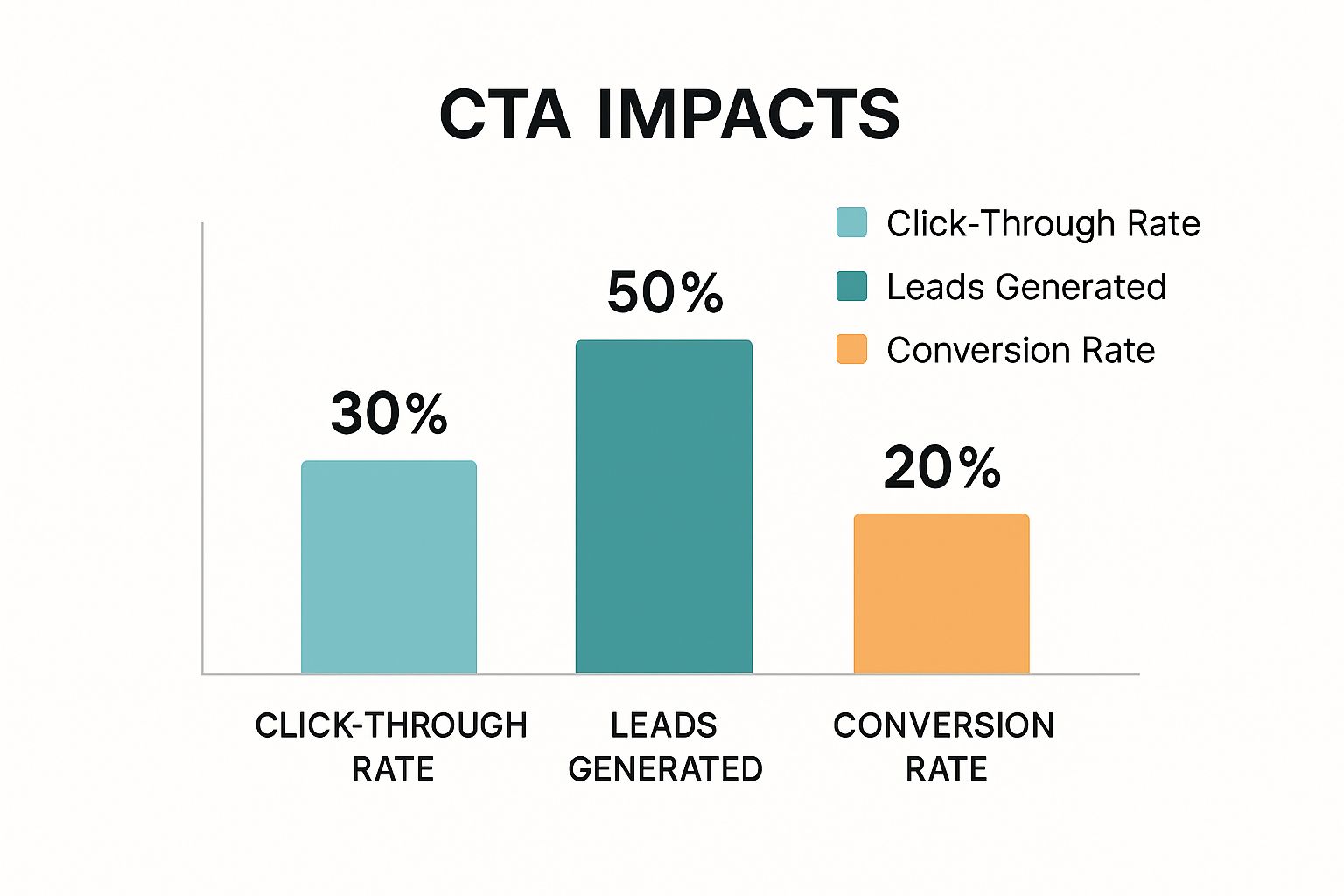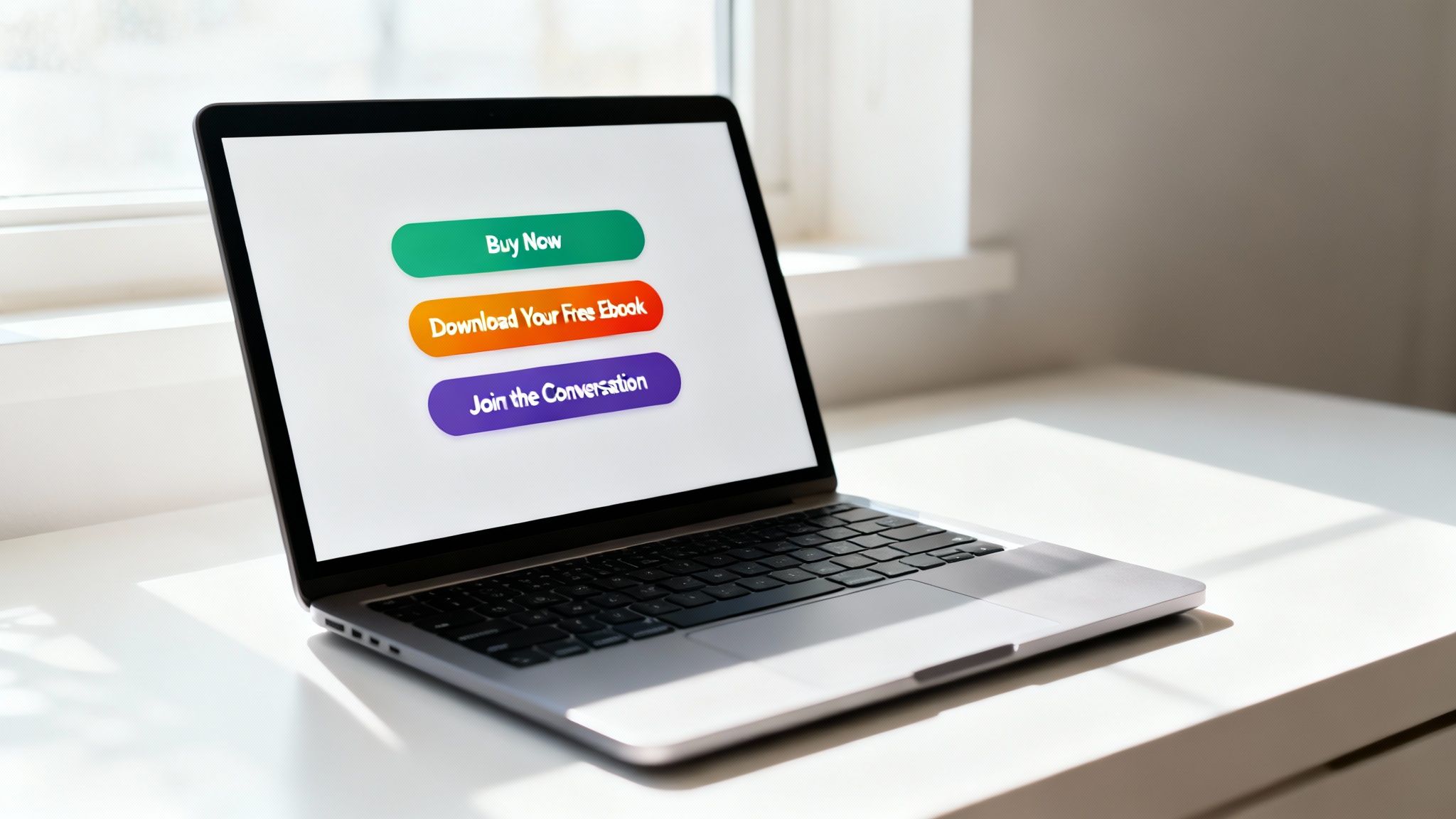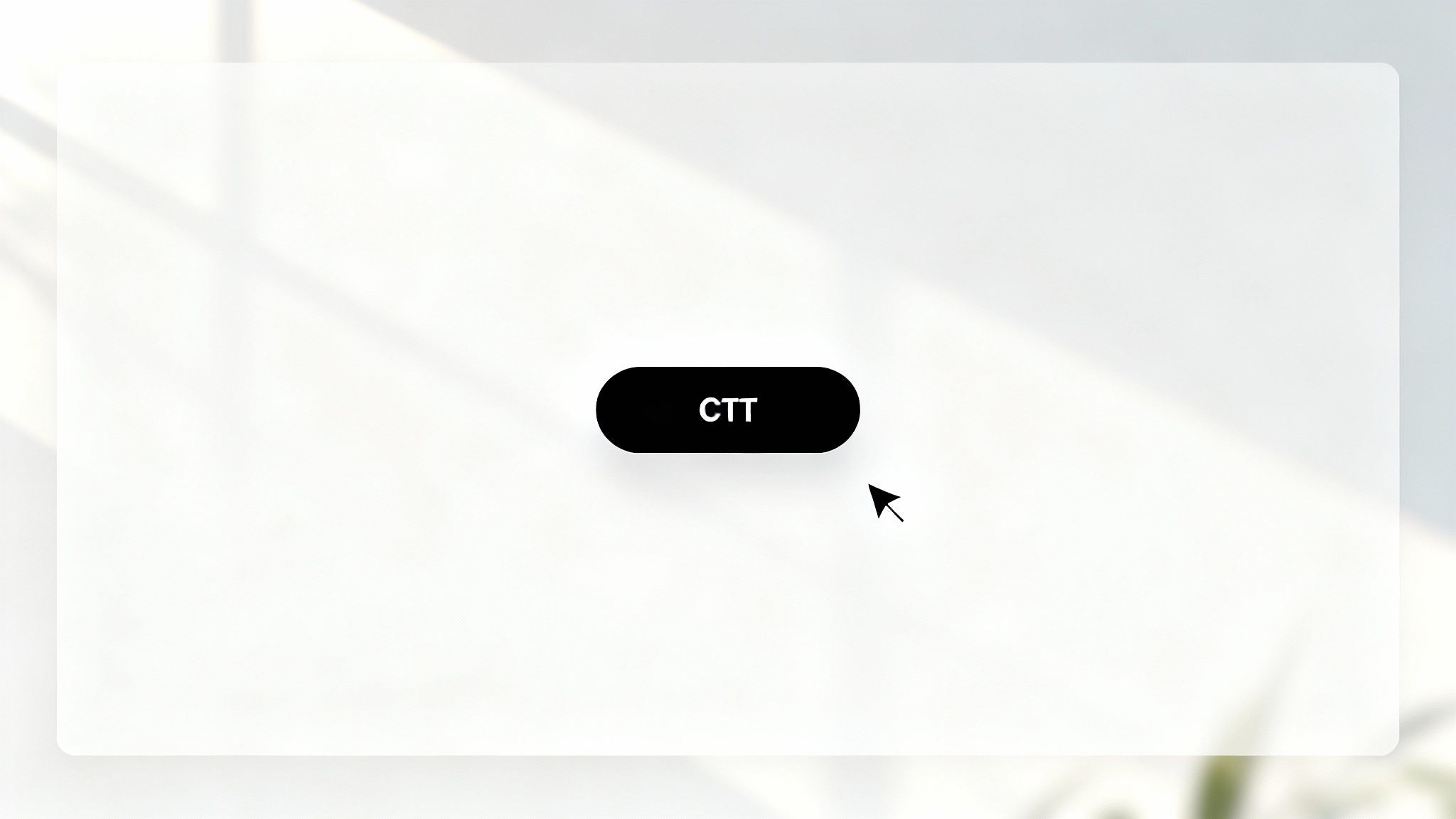What Is Call to Action? Tips to Boost Conversions
This article was assisted with AI. We may include links to partners.
On your website, every button, link, and phrase has a job to do. The most important job belongs to the call to action (CTA). Simply put, a CTA is a direct instruction telling your visitor what you want them to do next. It’s the “Buy Now” button, the “Sign Up for Free” link, or the “Download Your Guide” image.
What Is a Call to Action and Why It Matters
Imagine your website is a conversation with a potential customer. You've shared valuable information and built trust. The call to action is how you end that conversation with a clear, confident next step.
Without a CTA, your visitors are left hanging. They might be impressed, but they don't know where to go from there. A good CTA acts as a friendly guide, leading them exactly where you want them to go. It turns a passive browser into an active participant.
Actionable Tip: End every key page (homepage, service pages, blog posts) with a single, clear CTA. Don't assume visitors will know what to do next. Guide them.
This is the bridge between a visitor simply reading your content and taking a meaningful action that grows your business, like:
- Generating Leads: Encouraging someone to download a free resource in exchange for their email.
- Driving Sales: Moving a shopper from a product page to the checkout with a bold “Add to Cart” button.
- Building Your Audience: Prompting a reader to subscribe to your newsletter.
Every goal you have for your website hinges on a strong call to action. Leaving it out is like telling a great story without a conclusion.
The Impact of a Strong CTA
A well-designed call to action has a massive impact on your bottom line. The right CTA can dramatically improve your website's performance, turning casual traffic into tangible results.

The numbers don't lie. Making your CTAs clear, compelling, and easy to spot is one of the most direct ways to boost your website’s success. It’s not just a button; it’s your primary tool for turning interest into action.
A CTA has a few core jobs to do. This table breaks down exactly how it turns passive visitors into active participants.
| The Core Functions of a Call to Action | |
|---|---|
| Function | What It Does for Your Business |
| Guides the User | Eliminates confusion and tells visitors exactly what to do next. |
| Creates Urgency | Uses action-oriented language to encourage an immediate response. |
| Drives Conversions | Directly links your content to a business goal, like making a sale or booking a demo. |
| Provides Clarity | Sets clear expectations for what will happen when a user clicks, building trust. |
Ultimately, the call to action is the linchpin of your entire online strategy. By mastering it, you gain control over the user journey and can start reliably turning visitors into customers.
Exploring Different Types of CTAs

A common mistake is thinking every CTA has to scream "Buy Now!" The reality is, you need different kinds of prompts for different stages of the customer journey.
The classic "Buy Now" button is just one tool in a much bigger toolbox. Choosing the right one comes down to your goal for that specific page. Are you trying to build your email list, educate a potential customer, or close the deal? Each objective needs a different approach.
A personalized CTA—one that's tailored to a user's behavior or where they are in their journey—has been shown to perform 202% better than a generic one. This highlights the importance of matching your CTA to the user's context.
Let's break down the main categories.
Lead Generation and Nurturing CTAs
The main goal here isn't to sell, but to start a conversation. You're offering something valuable in exchange for a visitor's contact info, turning an anonymous browser into a known lead.
- Download Our Free Guide: Perfect for visitors in the research phase.
- Join Our Newsletter: A low-commitment way to stay in touch and build an audience.
- Get a Free Quote: Targets users who are actively considering a purchase.
Sales and Transactional CTAs
When a visitor is ready to make a commitment, these are the CTAs you use to seal the deal. Their purpose is direct: drive a conversion. They must be as simple and frictionless as possible.
For service-based businesses, a crucial call to action is often an invitation for prospective clients to directly book a demo.
To help you match the right CTA to your goal, this table breaks down common examples.
Matching CTA Types to Your Business Goals
| CTA Type | Primary Goal | Example Text |
|---|---|---|
| Direct Sale | To complete a purchase immediately. | "Add to Cart" or "Buy Now" |
| Free Trial | To let users experience the product. | "Start Your Free 14-Day Trial" |
| Sign-Up | To create an account or membership. | "Create Your Account" |
Actionable Tip: Review your top 5 most visited pages. Does the CTA on each page match the visitor's likely intent? A blog post reader might want a newsletter sign-up, not a "Buy Now" button.
Writing CTA Copy That Inspires Action

The words you choose for your call to action are everything. We've all seen boring buttons like "Submit" or "Click Here." They work, but they don’t inspire action.
Your goal is to write copy that makes people want to act now. Your CTA has to be clear, persuasive, and focused on what the user gets in return for their click.
Use Strong, Action-Oriented Verbs
The best CTAs start with a punchy verb. It immediately tells the user what to do and creates momentum.
Actionable Tip: Instead of vague words like "Submit," use verbs that promise a clear benefit:
- Get Your Free Quote
- Claim Your Discount
- Discover a Better Way
- Unlock Exclusive Content
These aren't just commands; they're invitations to gain something valuable.
Create Urgency and Communicate Value
Another powerful technique is adding a little urgency. Phrases that hint at a limited time or supply tap into the fear of missing out (FOMO).
Before: Shop Our Sale
After: Shop Now, Offer Ends Tonight
That small tweak shifts the dynamic from a passive suggestion to an urgent opportunity. When you combine urgency with a clear value proposition—like "Unlock Your Free Trial"—you give visitors an irresistible reason to click right now.
Designing CTAs That Get Noticed and Clicked

Even the most brilliantly written call to action is useless if nobody sees it. Design is your secret weapon for making your CTA button the most obvious, can't-miss element on the page.
The single most critical factor here is contrast. Your button's color needs to pop against the background. If your website has a cool blue theme, a bright orange button will stand out far more than another shade of blue.
Mastering Visual Hierarchy and Placement
"Visual hierarchy" simply means arranging things on a page to show what’s most important. Your CTA needs to be at the top of that list.
Here are actionable tips to make your CTA the star of the show:
- Size Matters: Your CTA button should be large enough to be easily seen and tapped, especially on a phone.
- Embrace White Space: Don't crowd your button. Leaving empty space around your CTA helps it stand out.
- Strategic Placement: Put your CTA where people's eyes naturally land, usually right after you've explained the value of your offer.
The visual presentation of your CTAs is a huge deal. You can learn more about specific strategies by optimizing landing pages for better CTA performance.
Design and placement are proven conversion drivers. Simply increasing the size of a CTA button can boost click-through rates by 90%, while changing its color can increase conversions by 21%.
These principles are absolutely vital when you want to create high-converting landing pages that boost sales. Good design ensures your visitor isn’t just told what to do—they’re visually guided to do it.
Using Smart CTAs for Personalized Experiences
Imagine your website could show every visitor the perfect message, tailored just for them. That’s the power of smart CTAs. Instead of showing the same generic button to everyone, a smart call to action changes based on who is looking at it.
This works by recognizing different things about your visitors, such as their location or if they are a new or returning customer. It's like a great barista who remembers your usual order.
How Smart CTAs Drive Engagement
This tailored approach makes users feel understood. The data shows it works: personalized CTAs convert a staggering 202% better than standard versions. If you're curious about the numbers, you can explore the research on CTA performance for yourself.
Here are a few real-world examples:
- Location-Based: A visitor from Canada might see "Shop Our Winter Collection," while someone browsing from Australia sees "Explore Our Summer Styles."
- Visitor Status: A brand-new visitor could be greeted with "Discover Our Features," but a loyal, logged-in customer is shown "Upgrade Your Plan."
- Past Behavior: If someone previously downloaded an ebook on marketing, their next visit might feature a CTA for a "Marketing Strategy Webinar."
Actionable Tip: Start simple with personalization. If you have a login feature, try creating one CTA for logged-out visitors ("Sign Up Free") and another for logged-in customers ("Explore Your Dashboard").
This level of personalization used to be complex, but tools like the Solo AI Website Creator are making it much more accessible. By tailoring your call to action to the individual, you dramatically increase its relevance and effectiveness.
How To Create Your CTA With Solo AI Website Creator
So, how do you put this all into practice? With the right tools, you can get a professional, high-impact call to action onto your website in minutes—no coding necessary.
The Solo AI Website Creator was designed to make this process straightforward for anyone, regardless of technical skill. You can add, edit, and style your CTA buttons directly on the page.
A Simple Walkthrough
This quick, hands-on tutorial shows you exactly how to add a button, write your text, and tweak the design to make it impossible to ignore.
- Add a Button Block: Find the perfect spot on your page for your CTA. Click to add a new content block and select the "Button" option. A new CTA button will appear on your page.
- Customize Your Text: Click directly on the button to change the text. Swap out the placeholder with your own action-focused copy, like "Claim Your Free Trial" or "Get Started Today."
- Adjust the Design: Use the simple styling options to change the button's color and size. A good rule of thumb is to pick a high-contrast color that stands out from the page's background to grab a visitor's attention.
Ready to see what else the platform can do? You can meet the Solo AI Website Creator and explore all of its features.
Common Questions We Hear About CTAs
Even with a great plan, a few questions always pop up when it's time to build your calls to action. Let's tackle the most common ones.
How Many CTAs Should I Put on One Page?
It's best to stick with one primary call to action that supports the page's main purpose. If it's a product page, that's almost always an "Add to Cart" button.
You can have secondary CTAs, like a "Join Our Newsletter" link, but they should be much less noticeable. Too many competing choices create "decision paralysis," where an overwhelmed visitor chooses nothing.
Actionable Tip: On your homepage, have one main CTA "above the fold" (visible without scrolling) and repeat it at the bottom. Use less prominent secondary CTAs for other goals, like a newsletter sign-up in the footer.
What Is CTA A/B Testing?
A/B testing, or split testing, is like a competition between two versions of your CTA to see which performs better. You might show a red "Get Started" button to 50% of your visitors and a green "Create Your Account" button to the other 50%.
This data-driven method shows you which one actually gets more clicks. It allows you to make decisions based on real user behavior instead of just guessing.
Can a CTA Just Be Text Instead of a Button?
Absolutely. While buttons grab attention, a simple hyperlinked sentence can be a very effective call to action. You’ll often see these in blog posts or emails to guide readers to related content.
A classic example is, "For a deeper dive, read our complete guide to SEO."
Now that you have the knowledge, it's time to build. Solo AI Website Creator makes it easy to add high-converting CTAs to a professional website in minutes. Create your free website today.
